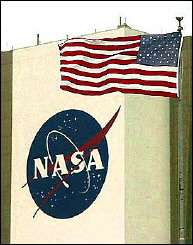Shuttle Still Dominates But Exploration Vision Taking Over At NASA

The space shuttle continues to occupy the biggest budget line item in NASA's funding request for fiscal year 2007, but the agency will be devoting a large percentage of its spending to launch the new Vision for Exploration in the near future, and is subtly ramping up its activity toward that end.
For example, NASA has moved up by two years - to this summer - its time for choosing the initial design for the Crew Exploration Vehicle, the spacecraft intended to replace the space shuttle fleet.
NASA's detailed budget figures show that its planned spending on the CEV and related programs, collectively called Project Constellation - which the agency has proposed to increase to $3.1 billion in FY 2007, compared with $422 million in FY 2005 - will jump to nearly $7.7 billion in FT 2011, or nearly double the current funding level for the shuttle fleet, beginning the first year after the shuttle is scheduled to be retired.
"This budget affirms NASA's commitment to assuring the nation's continued human access to space," the budget document states. That commitment requires using Constellation to replace the shuttle, which by FY 2011 will be 30 years old.
The goal of the funding targets is bring the Constellation systems - including the CEV and the Crew Lifting Vehicle - online as close to FY 2010 as possible, so NASA will have the smallest gap possible between the end of the shuttle program and the beginning of Constellation.
"Operational availability for the CEV and CLV is targeted for no later than 2014 (and) NASA will strive to bring that date as close to 2010 as possible," the budget document states. "Following the initial capabilities, Constellation will develop crew and cargo capabilities for a lunar surface mission as early as 2018, but not later than 2020."
NASA's current plans call for developing a Heavy Lift Launch Vehicle, an Earth Departure Stage, a Lunar Surface Access Module, and related capabilities. Engineers will will conduct a detailed review of Constellation, and the agency will attempt to engage its field centers and contractors, to finalize the technical requirements and operational dates for the CEV and CLV.
"NASA is committed to getting it right," the agency said in the document.
Toward that end, NASA has proposed spending about $3.1 billion on Constellation in FY 2007, and intends to request slightly more for FY 2008, about $3.6 billion for FY 2009, $4.1 billion for FY 2010, and $7.7 billion the following year.
A large chunk of that money is intended to go for the CEV. NASA has asked for $839 million for FY 2007, and according to its budget plans will ask for comparable amounts for two more years, but the request is expected to jump to $1.1 billion in FY 2009, and about $2 billion in FY 2010 and FY 2011.
NASA's concept calls for the CEV design to be an Apollo-like capsule, capable of transporting four astronauts at a time to the lunar surface, which the agency wants to attempt no later than 2020.
Likewise, another big money commitment soon will be going for the CLV. Though NASA's request for the current fiscal year is $384 million for the program, the agency's new budget proposal raises that figure to $837 million. Further increases will take it to $917 million in FY 2009, $1.1 billion in FY 2010 and $2.2 billion in FY 2011.
As announced by President George W. Bush in 2004, NASA is gradually reducing funding for the space shuttle. The FY 2007 request is $4.1 billion, down 25 percent from FY 2005, and though spending is expected to hold at that level for one more year, it will decrease to $3.8 billion in FY 2009 and $3.7 billion in FY 2010, then drop precipitously to $147 million in FY 2011, covering what would be essentially shut-down activities.
At the same time, however, funding for NASA's involvement in the International Space Station shows no signs of slowing down, and in fact is expected to increase over the next several years. The request for FY 2007 is $1.8 billion, but over the four succeeding fiscal years, proposed spending would be $2.2 billion, over $2.2 billion, nearly $2.2 billion and $2.4 billion, respectively.
"NASA is examining ISS configurations that meet the needs of both the new space Exploration Vision and our (16) international partners," the agency said, "while using as few shuttle flights as possible. Consistent with the ISS research agenda, and operations and international commitments, NASA is committed to provide for a crew size of six.
Another key element in the future of the ISS program is the use of alternate cargo and crew transportation services to supplement the Shuttle when it is in service, and to replace it when it retires."
Copyright 2006 by Space Daily, Distributed United Press International

















